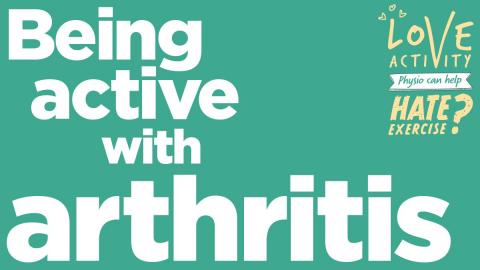There are many types of arthritis, including osteoarthritis (OA) and rheumatoid arthritis (RA). These cause pain, heat and stiffness in your joints and can affect people of all ages. This summary explains how physiotherapy can help.
On this page:
What is arthritis?

There are more than 200 types of arthritis and related conditions. In osteoarthritis the joints show signs of wear and tear, which increases as time goes by. In rheumatoid arthritis, the body’s immune system attacks the joints, which can become red and swollen if not treated.
Most types of arthritis have several causes. If there is arthritis in your family, you may be more likely to develop it. However, arthritis can start suddenly, without any obvious cause, at any age.

How can physiotherapy help manage arthritis?
Exercise can help to manage some of the symptoms of arthritis. Physios provide advice and education on exercise, pain relief and ways to manage your condition. They can teach you how to improve your joint movement and your walking, as well as how to strengthen your muscles.
Your physio may offer exercise in water, at perhaps your local swimming pool. They may also offer acupuncture for some conditions. Being active can really help you to stay mobile and independent.
You are also likely to see a physiotherapist before and after a joint operation, such as a total knee (TKR) or total hip (THR) replacement. The physio will help you walk properly and make sure you are recovering well.
What will happen when I see a physiotherapist?
When you see a physio, they will assess your problem and give you advice. They may give you a physical treatment. Everything you tell the physio will be completely confidential.
So that your physio can have a good look at how you move, they may need you to remove some clothes. It’s a good idea to dress comfortably and wear suitable underwear.
Physios are the third largest health profession after doctors and nurses. They work in the NHS, in private practice, for charities and in the work-place, through occupational health schemes. Physiotherapy has been shown to work through clinical studies and research and is a treatment you can trust.
How can I help myself?
There are exercises that can reduce joint pain and ways to try and avoid it coming back. Depending on the individual person, changes in your posture and life style may be useful.
Learning how to ‘pace’ yourself will help you to carry on with your usual activities. Pacing yourself means that you keep active without overusing an arthritic joint.
Top tips for arthritis care
- Keep active. Work on keeping your muscles strong and your joints moving
- Maintain a healthy weight, so your body is not too heavy for your joints to carry
- Avoid making an inflamed joint worse
- Get advice on how to manage your condition yourself
- Seek advice to see if walking aids, a support or brace would help
- Good posture will help you carry your body weight evenly, using both your arthritic and non-arthritic joints. Poor posture can cause problems with your healthy joints, as well as your digestion and breathing
- Use cooling packs over painful joints according to manufacturer's instructions. The area round the joint should have good circulation and don’t leave the pack on for too long
Links and further information
- Arthritis research, education and information: Versus Arthritis
- Exercise advice leaflets
- Comprehensive information on arthritis: NHS Choices
Disclaimer
The content on this page is provided for general information purposes only and is not meant to replace a physiotherapy or medical consultation. The CSP is not responsible for the content of any external sites, nor should selection be seen as an endorsement of them.
